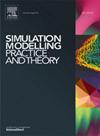Development and assessment of a spreadsheet-based decision support framework for optimal reconstitution of cohesionless soils
IF 3.5
2区 计算机科学
Q2 COMPUTER SCIENCE, INTERDISCIPLINARY APPLICATIONS
引用次数: 0
Abstract
Analyzing various geotechnical problems associated with cohesionless soils necessitates the creation of a physical model exhibiting a uniformly reconstituted soil structure. However, reconstituting such a well-conditioned model with complex reconstitution criteria or goals using the conventional air pluviation technique is an intricate task. To address this challenge, the present study proposes a novel Spreadsheet-based Pluviation Parametric Optimizer (SPPO), which is purposely developed for the systematized, controlled, and optimal reconstitution of cohesionless soils. A cohesive integration of a Mechatronic-Assisted Air Pluviation System (MAPS) and the Taguchi-VIKOR-based Multi-response Optimization (TV-MRO) algorithm, devised through SPPO, is utilized to achieve the aforementioned optimal reconstitution. To verify the competence of the decision support framework offered by SPPO, the reconstitution of a poorly graded quartz sand (D50=0.22 mm) considering five modelled reconstitution scenarios was conducted. For each modelled reconstitution scenario, SPPO identified an optimal pluviation setting, which was further validated by a confirmatory experiment and a devised optimality criterion. Additionally, it was revealed that the height of fall is the most influential parameter in optimal reconstitution, followed by diffuser ratio and sieve porosity. Overall, it is anticipated that the adoption of SPPO can be effective in reconstituting cohesionless soils with much less reconstitution effort, time, and resource deployment compared to conventional reconstitution methodologies.
基于电子表格的无黏性土壤最佳重构决策支持框架的开发和评估
分析与无黏性土壤相关的各种岩土工程问题,需要创建一个显示均匀重构土壤结构的物理模型。然而,使用传统的空气降水技术重建具有复杂重建标准或目标的条件良好的模型是一项复杂的任务。为了解决这一挑战,本研究提出了一种新的基于电子表格的降水参数优化器(SPPO),它是专门为无黏性土壤的系统化、可控和最佳重构而开发的。利用SPPO设计的机电辅助通风系统(MAPS)和基于田口-维科(taguchi - vikori)的多响应优化(TV-MRO)算法的内聚集成来实现上述优化重构。为了验证SPPO提供的决策支持框架的能力,考虑五种模拟重构情景,对一种差级配石英砂(D50=0.22 mm)进行了重构。对于每个模拟重建场景,SPPO确定了一个最优的降雨环境,并通过验证性实验和设计的最优准则进一步验证了这一结果。结果表明,沉降高度是影响最优重构的参数,其次是扩散比和筛孔率。总的来说,预计采用SPPO可以有效地重建无黏结性土壤,与传统的重建方法相比,重建的努力、时间和资源部署要少得多。
本文章由计算机程序翻译,如有差异,请以英文原文为准。
求助全文
约1分钟内获得全文
求助全文
来源期刊

Simulation Modelling Practice and Theory
工程技术-计算机:跨学科应用
CiteScore
9.80
自引率
4.80%
发文量
142
审稿时长
21 days
期刊介绍:
The journal Simulation Modelling Practice and Theory provides a forum for original, high-quality papers dealing with any aspect of systems simulation and modelling.
The journal aims at being a reference and a powerful tool to all those professionally active and/or interested in the methods and applications of simulation. Submitted papers will be peer reviewed and must significantly contribute to modelling and simulation in general or use modelling and simulation in application areas.
Paper submission is solicited on:
• theoretical aspects of modelling and simulation including formal modelling, model-checking, random number generators, sensitivity analysis, variance reduction techniques, experimental design, meta-modelling, methods and algorithms for validation and verification, selection and comparison procedures etc.;
• methodology and application of modelling and simulation in any area, including computer systems, networks, real-time and embedded systems, mobile and intelligent agents, manufacturing and transportation systems, management, engineering, biomedical engineering, economics, ecology and environment, education, transaction handling, etc.;
• simulation languages and environments including those, specific to distributed computing, grid computing, high performance computers or computer networks, etc.;
• distributed and real-time simulation, simulation interoperability;
• tools for high performance computing simulation, including dedicated architectures and parallel computing.
 求助内容:
求助内容: 应助结果提醒方式:
应助结果提醒方式:


